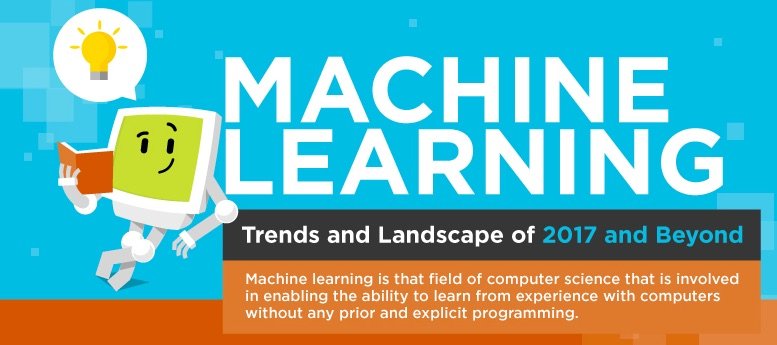Machine learning is that field of computer science that is involved in enabling the ability to learn from experience with computers without any prior and explicit programming.
The global cognitive computing market is expected to reach $12.5 billion in 2019, up from 2.5 billion in 2014, at a CAGR of 38% (Research and Markets)
Gartner forecasted 6.4 billion connected things would be in use worldwide in 2016, up 30% from 2015, and will reach 20.8 billion by 2020.
IDC (International Data Corporation) forecasts global spending and related services to grow at a compound annual growth rate (CAGR) of 17% from more than $71 billion in 2015 to $135.4 billion in 2019.
Special thanks to Infographic Design Team for the creation of the infographic.

Examples of machine learning applications include:
- A security startup using machine learning to spot patterns and catch cyber criminals.
- A farmer using machine learning to sort cucumbers.
- A machine learning-based modeling scheme that generates 3D models of residential buildings from photographs
- A predictive tool that optimises social media for online publishing
- An AI app that collects data from social account and conference registrations to help people network at events
- A platform that processes customer queries and responds in natural language drawing on what it has learned from email, surveys and social media
The cognitive computing market size is expected to surpass 12 billion by 2022 (Grand View Research).
Years 2016 and 2017 are exciting times for Machine Learning. There are more complex tasks, more domains, and more acceptance of ML as the way to exploit data everywhere.
Google, Microsoft, Facebook and IBM: AI partnerships are there for a reason.
Now, let’s check out the rising ML tends!
Machine Learning: Trends and Landscapes of 2017 and Beyond Inforgraphic Summary:
The level of supervision of the machine learning in the neural networks is decreasing and one can expect a purely unsupervised neural network or application to emerging soon.
Unlike the conventional machine translation by programming methods, deep learning has yielded Neural Machine Translation (NMT).
A prominent example of this shifting trend is Google translate. Google recently announced that their translate service is adopting NMT more than their previous statistical methods.
The constant explosion of data and consequent adoptions of machine learning constitutes a data flywheel that is expected to expand constantly in 2017.
An example is of Tesla, where the data collection rate is at a million miles of driving data every 10 hours.
Conventional and digital marketplace will be replaced with newer and much organised algorithm marketplace for exchanging ideas, gain useful data patterns, useful for their field of expertise.
- CLOUD-HOSTED INTELLIGENCE
Cloud-hosted Artificial Intelligence is expected to reduce costs for companies in need of developing such a system.
Cloud-hosting will get more accurate and yield faster results due to greater specialization by the ML service providers.
- ML in the HEALTHCARE SECTOR
Adoption of ML concepts and applications such as Deep Learning will improve medical imaging, analysing clinical data, making sense of genomic data of large, diverse populations.
IBN’s Watson is a prominent example.
- ML in the CONSTRUCTION SECTOR
In the constructions sector, apart from the obvious application in modelling buildings, ML can be useful for selecting the best materials, the best companies or services according to the region of construction.
The autonomous TMA truck is a great example, which intelligently predicts safety drivers of the truck.
- MACHINE-HUMAN COOPERATION
Contrary to doomsday-like predictions that the greater the artificial intelligence, the greater the job loss, it is expected that increased cooperation between humans and machines will lead to better quality outcomes.
Below are a few top machine learning algorithms used by data scientists:
- Supervised Machine Learning Algorithms
- Linear Regression
- Logistic Regression
- Unsupervised Machine Learning Algorithms
- Reinforcement Machine Learning Algorithms
- Artificial Neural Networks
- Naïve Bayes Classifier Algorithm
- Random Forests
- K Means Clustering Algorithm
- Decision Trees
- Support Vector Machine Algorithm
- Nearest Neighbours
- Apriori Algorithm
2017 will be a big year for Machine Learning, Internet of Things and Artificial Intelligence. If we are really lucky, 2017 will bring us a machine that can beat humans at making a cup of coffee.
